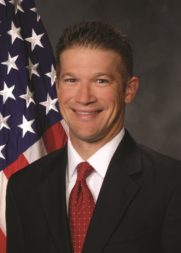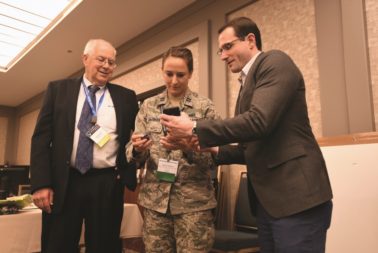Many small companies are wary of government work. Executives have heard stories of red tape and slow payments. David Shahady, who directs the Air Force Small Business Innovation Research (SBIR) and Small Business Technology Transfer programs, is intent on changing those perceptions.

Since Shahady moved into his job in late 2015, he has been looking for ways to make it easier for innovative small companies to work with the U.S. Air Force. That effort got a shot in the arm in 2018 when Will Roper became Air Force assistant secretary for acquisition, technology and logistics. Roper, who says he wants to turn the Air Force into “a 21st century tech investor,” is working with Shahady to revamp the SBIR program.
The two men were in San Francisco in November for Air Force Space Pitch Day where 30 companies received a total of $22.5 million in SBIR funding. At the event, Lt. Gen. John “JT” Thompson, Air Force Space and Missile Systems Center (SMC) commander, Roper and Shahady repeatedly emphasized the Air Force’s efforts to knock down legal, contracting and financial barriers to working with innovative small businesses.
Shahady spoke with SpaceNews about Air Force Space Pitch Day and about the Air Force’s SBIR program.
How much money does the Air Force have for SBIR?
Every government program has a research, development, test and evaluation line. A portion of that is set aside by law as part of this SBIR program. For the Air Force, it is almost $800 million in 2019. Organization with venture capital budgets of over $500 million are in the top tier of venture capital. I don’t think people look at the Air Force as a venture capital entity. I want to see us break that barrier where the industry sees us as a true innovation and venture partner.
Most venture partners claim a share of a company’s equity.
We’re a tremendous deal. We are a wonderful organization to work with because we don’t want equity. Our mission is to build the U.S. economy’s industrial base to support the military.
What is different about SBIR phase one, two and three?
It’s relatively simple. Phase one is a small amount of money, anywhere from $50,000 up to $150,000. It’s about developing a concept or idea. In some cases, we pay companies to do customer discovery.
A lot of companies at Space Pitch Day said they got $50,000 phase one SBIR awards for customer discovery.
That’s a model that we’re looking at. Do I want the companies to spend their own dollars figuring out if it’s good to do business with the Air Force? I can upfront that cost and have that company go around and talk to customers and find the right fit for them in the Air Force as opposed to them having to do that on their own dime.
Phase two is where you develop a prototype, do a demonstration and you show your applicability. We’re allowed to do several phase two awards. Awards can be as much as $3 million on a phase two. Phase three is basically graduation from the [SBIR] program because somebody other than the SBIR program is investing.

Is that similar to the way Defense Advanced Research Projects Agency programs continue by transitioning to a military customer?
Yes. That’s a great example. The neat thing about the SBIR law is that it’s not service-specific or organization-specific. If you have an SBIR contract with any organization within the government, anybody else can capitalize on what you have been doing.
Some of the companies here told me that they were invited but they couldn’t pitch because they had NASA SBIR funding not Air Force SBIR funding.
Every center, every organization sets the parameters on how they want to manage SBIR. When I took over, SBIR was very centralized with a lot of Air Force policies. I read through those and I read through the law and I decided that we were interpreting all of that wrong. I got rid of all of our Air Force policies and I tied it straight to what we were allowed to do legally. I gave that power back to all the commanders and the center leads so that they could best use this tool for them, making them the true owner in the process.
What’s really special about what General Thompson is doing here is that he’s bringing some of his own dollars to these programs. Companies are going from SBIR phase one, which is a concept, all the way to phase three almost in one fell swoop because we’re awarding the phase two here and the General is picking some of them and putting some [SMC] dollars on those.
When people get $1.5 million or $3 million at Space Pitch Day are those SBIR phase 3 awards?
Yes. That’s a really exciting proposition for me because traditionally it could take as long as five to seven years to see a program get to maturity where other people were investing in it. We got that time down to two to three years. But this is less than 12 months from somebody coming in with a proposal to somebody in the formal Air Force saying, “This is indeed something that we want to have as part of our programs of record.” That’s a tremendous, powerful message.
If they get $3 million today, does it mean they’re going to be part of a program of record?
Well, it means they’re on the road. Anytime you have somebody else investing, putting their skin in the game, they have a vested interest in seeing that program be a success.
How is the SBIR program changing?
The financial and the contracting community have knocked down lots of barriers, everything from shortened contracts to paying with a government credit card to giving people their initial money upfront. For the companies getting awards, we’re depositing $50,000 off a credit card in their bank account right here, today. That doesn’t sound like much, but to a small company their funding stream is their lifeblood. In the past, companies that won SBIR awards would take out business loans because they felt like it would be six to nine months before they got their first payment. If they can win an award and get paid immediately, there isn’t the need to take that risk. They’re now working on our dime instead of their own, which is the proposition that we want to see.
In the past, some small firms continuously worked on SBIR programs.
There was obviously a trend that had happened within SBIR. There were companies that did one SBIR after another and made a business out of that. I don’t want that to be our model because the intention is to help them become a more mature part of the business community and the economy. We do a lot of things to help a company build a business plan. Many companies get so technology-focused that they don’t spend any time thinking about their business and how they’re going to make their business grow. It’s easy to be satisfied that I got some small business money and I’d like to go back and get more small business money. But that’s not teaching them how to fish. That’s giving them a fish for the day.

Our intention is to make them a viable part of the economy. Let’s make it so that the large prime contractors that are doing space assets or cyber assets or whatever see that small business as a great supplier. Or, maybe they’re a great supplier directly to the military. I don’t want them necessarily eating our seed corn for the rest of their business’s life. I want them to become a mature business. It’s OK for them to want to make money. They should be looking to make money. They should be looking to hire more people. I joke all the time [with entrepreneurs] that I’m looking forward to driving by their big houses and then going to my little house to eat ramen noodles. I’m OK with that. A lot of times we give small businesses the feeling that we don’t want them to succeed as a company, but that’s not the case. We want them to succeed.
Will Roper seems very enthusiastic about the SBIR program.
It’s been great working with him. He’s been such a tremendous advocate of the program. When he realized he had this pot of (SBIR) money, he asked, “Who runs that?” The next thing you know, we brainstormed about a lot of different things. He’s in the position where he could give us the top-level support. All of a sudden, I found myself with almost an unlimited ability to make changes.
Within the restrictions of the law?
That law has got a lot of room. If you embrace the spirit of these laws and see why Congress put these laws in place, it becomes really easy to do the right thing.
People at Space Pitch Day have been talking about co-investing or matching funds is that part of SBIR phase 3?
Yes. That’s our way of us saying, “I’ll put some of our money up, but I’d like to see that somebody else is also putting their money up.” It’s the model of, “Sure, we’ll give you money for an associate degree. We’d like to partially fund a bachelor’s degree. But I expect by the time you’re getting a master’s or a Ph.D. that somebody else is going to be footing the bill.”
The idea of getting people to match funding earlier shows that somebody has an interest. People are more than willing to have you invest money if you’re the only one taking the risk. But if they are investing also, there’s a tendency for them to draw on it. That’s why I mentioned the programs of record. If they’re putting some of their money in, they’re more incentivized to help that company succeed or to give it the attention that it needs to see if it’s successful.
Could the matching funding come from commercial firms, military organizations?
Anywhere. I don’t think we want to put any restrictions on a company. The more flexibility we give them, the better. If they can find it from the Air Force, that’s ideal. If they can find outside money from state and local governments, other services, venture capital investors, large primes or even commercial sales, those are all great propositions because all of those things build up the industrial base. That’s a huge part of competing in a global market.
If we give people better opportunities than maybe there’s not a need to go to other outside suppliers. I am afraid of a time when as the Air Force I have to fight to get a small business to decide whether to work with us or whether to work with one of the folks that is not necessarily aligned with us. I want people to think the Air Force is great to work with, not that they can’t get a fair shake with us, that they can’t get traction with us.
This article originally appeared in the Dec. 11, 2019 issue of SpaceNews magazine.
#Space | https://sciencespies.com/space/air-force-rolls-out-red-carpet-credit-card-to-attract-small-business/
No comments:
Post a Comment